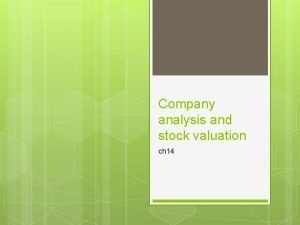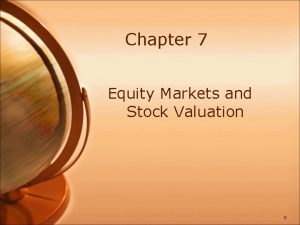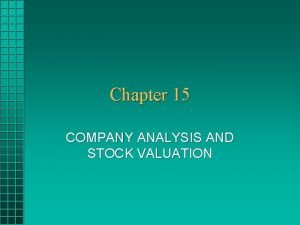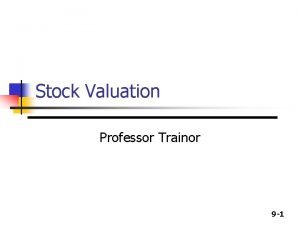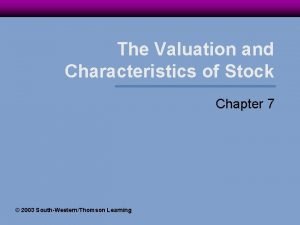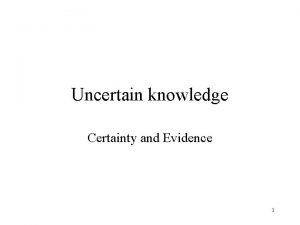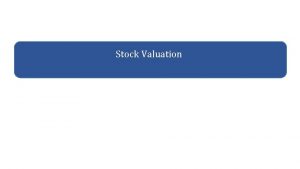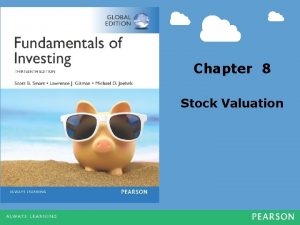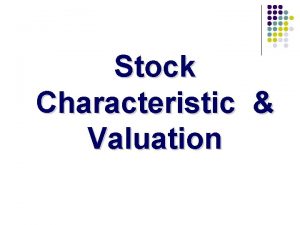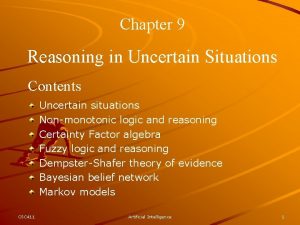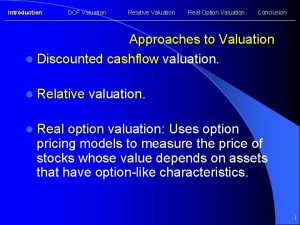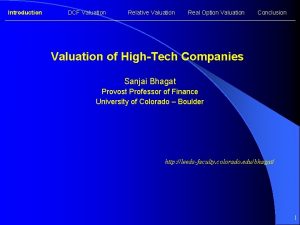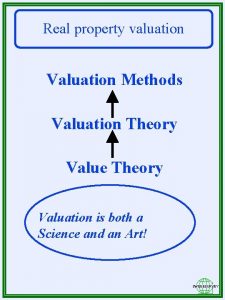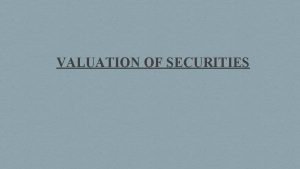Stock Valuation Common Stock Valuation is Difficult Uncertain












- Slides: 12

Stock Valuation

Common Stock Valuation is Difficult • Uncertain cash flows – Equity is the residual claim on the firm’s cash flows • Life of the firm is forever • Rate of return (the appropriate discount rate) is not easily observed

Differential Growth Dividend Model • Forecasted Dividends grow at a constant rate, g 1 for a certain number of years and then grow at a second growth rate, g 2. • Example: The dividend of a company was $1 yesterday. During the next 18 years the dividend will grow at 14% per year. After that the dividend will grow at 10% per year. What is the price of the stock if the required return is 15%?

The first dividend regime is a growing annuity The second dividend regime is a growing perpetuity

Now, we need to sum the two dividend regime values.

EPS and Dividends • Dividends (share repurchase) are a function of… – Ability to pay: Cash flow uncertainty – Decision to pay: Managerial uncertainty • Why does a manager retain earnings? – Has better investment opportunities than the shareholder – Makes a sub-optimal decision for the shareholder • What is a “better investment opportunity”? – Investment has a NPV>0

Value a firm that retains earnings? • Fundamental valuation equation: Sum of the discounted cash flows • First component: PV(no-growth earnings stream) – Remember EPS=Net income/Shareholders equity • Second component: PV of growth opportunities – Look for pricing shortcuts: perpetuity, annuity, etc. • Rule: As long as PV(GO) > 0, price increases

One Time Investment Opportunity • Firm expects $1 million in earnings in perpetuity without new investments. Firm has 100, 000 shares outstanding. Firm has investment opportunity at t=1 to invest $1 million in a project expected to increase future earnings by $210, 000 per year. The firm’s discount rate is 10%. What is the share price with and without the project?

Constant Growth, Constant Investing • Firm Q has EPS of $10 at the end of the first year and a dividend pay-out ratio of 40%, r. E = 16% and a return on investment of 20%. The firm takes advantage of its growth opportunities each year by investing retained earnings. • PV(GO) model – 1 st investment = 0. 6 × $10 = $6, which generates 0. 2 × $6 = $1. 20 – Per share PVGO 1 = -6 + (1. 20/0. 16) = $1. 50 (at t=1) – 2 nd investment = 0. 6 × $11. 20 = $6. 72, generating 0. 2 × $6. 72 = $1. 344 – Per share PVGO 2 = -6. 72 + (1. 344/0. 16) = $1. 68 (at t=2)

Constant Growth, Constant Investing (cont) • Relationship between PV(GO)’s? – 1. 68 = (1+g) × 1. 5 g=0. 12 • Is there an easier way to estimate g for this case? – G=ROI x Investment Rate=0. 2 x (1 -0. 4)=0. 12 • PVGO 0 = $1. 50 / (0. 16 - 0. 12) =$37. 50 • No-growth dividend value: $10/0. 16 = $62. 50 • P = $62. 50 + $37. 50 = $100

Constant Growth, Constant Investing (cont) • Can we price this firm a different way? – Since the investment grows at a constant rate we can immediately estimate g – Investment rate x ROI = 0. 6 × 20% = 12% • Then estimate PV(GO) as a growing perpetuity based on dividends rather than cash flow – D 1 / (r. E - g) = $4 / (0. 16 - 0. 12) = $100 • So the entire firm is worth $100

Another Example Firm X currently has expected earnings of $100, 000 per year in perpetuity. Firm X is switching its policy and wants to invest 20% of its earnings in projects with a 10% return. The discount rate is 18%. • No-growth price: P=$100, 000/0. 18 = $555, 555 • PV(GO) is a constant growth perpetuity – What’s g? g=Investment rate x ROI = 0. 2 × 10% = 2% – What is the first year’s investment cash flow? Invest $20, 000 and receive $2, 000 forever – -20, 000+(2, 000/0. 18)=-8888. 89 – PV(GO) = (-8, 888. 89)/(0. 18 -0. 02) = - 55, 555 • New Policy: P=$555, 555 - 55, 555 = $500, 000
 Common stock valuation
Common stock valuation Features of preferred stock
Features of preferred stock Characteristics of common shares
Characteristics of common shares Fixed income securities
Fixed income securities Company analysis and stock valuation
Company analysis and stock valuation Accounti g
Accounti g Avco stock valuation
Avco stock valuation Equity markets and stock valuation
Equity markets and stock valuation Company analysis stock valuation
Company analysis stock valuation Preferred stock valuation
Preferred stock valuation Characteristics of stock valuation
Characteristics of stock valuation Uncertain digit calculator
Uncertain digit calculator Representing knowledge in an uncertain domain
Representing knowledge in an uncertain domain




